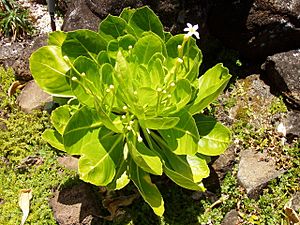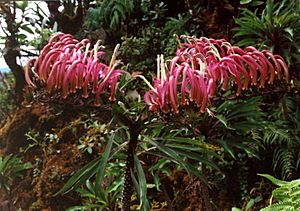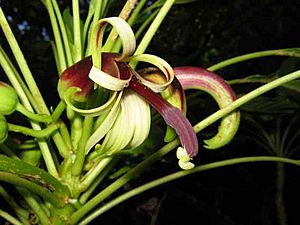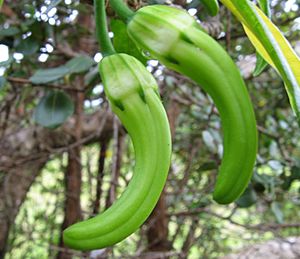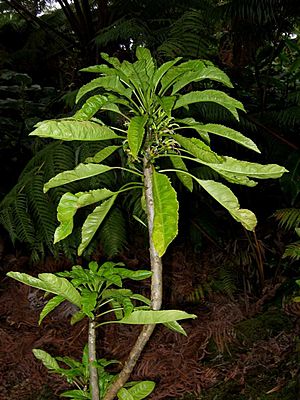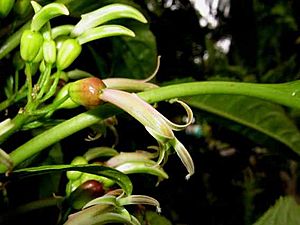Hawaiian lobelioids facts for kids
The Hawaiian lobelioids are a special group of flowering plants found only in the Hawaiian Islands. They belong to the bellflower family, called Campanulaceae. This group is amazing because it's the largest plant family that has grown and changed so much on any island group! There are over 125 different kinds of Hawaiian lobelioids.
These plants come in many shapes and sizes.
- Clermontia plants are usually shrubs or small trees, growing up to 7 meters (23 feet) tall. They have soft, fleshy fruits.
- Cyanea and Delissea usually grow as a single stem or branch from the bottom. They have a bunch of wide leaves at the top and also have fleshy fruits.
- Lobelia and Trematolobelia have long, thin leaves on a single, non-woody stem. Their fruits are dry capsules with seeds that spread by wind.
- Brighamia is unique! It has a short, thick stem with many wide leaves close together. Its flowers are long and white, and its fruits are also dry capsules.
For a long time, scientists thought these plants came from at least three different ancestors. But new DNA studies (from 1996 and 2008) show that all Hawaiian lobelioids likely came from just one ancestor. This ancestor was probably a Lobelia-like plant that arrived about 13 million years ago. That was when islands like Gardner Pinnacles and French Frigate Shoals were still tall islands, long before the main Hawaiian Islands we know today even existed!
Many Hawaiian lobelioids have beautiful and amazing flowers, especially those in the Lobelia and Trematolobelia groups. Sadly, they are also very easy for wild animals like feral pigs to eat. Their stems are not very woody and don't have many ways to protect themselves from being eaten. Their bark has a milky sap, which rats and pigs often chew. Young plants are also easily damaged by pigs digging in the ground. In areas with many pigs, you might only find lobelioids growing on larger trees or fallen logs, where pigs can't reach them.
Contents
Meet the Brighamia Plants
Brighamia plants are very different from the other lobelioids. They have a succulent (water-storing) stem and long, thin, tube-shaped flowers. Because of their unique look, scientists once thought they came from a separate ancestor.
These special features help Brighamia grow on cliffs and be pollinated by a rare Hawaiian hawkmoth called Manduca blackburni. This moth is now endangered itself and mostly lives on Maui, far from where Brighamia grows. Other hawkmoths, like the five-spotted hawkmoth (M. quinquemaculata) and pink-spotted hawkmoth (Agrius cingulata), might also help pollinate them. Even though they grow in hard-to-reach places on cliffs, botanists sometimes hand-pollinate Brighamia to make sure they produce seeds. Both species of Brighamia are now extremely rare. The genus is named after William Tufts Brigham, the first director of the Bernice P. Bishop Museum.
Brighamia species
- Brighamia insignis* A.Gray – ʻŌlulu (Kauaʻi, Niʻihau†)
- Brighamia rockii* H.St.John – Pua ʻAla (Molokaʻi, Lānaʻi†, Maui†)
† species believed to be extinct
* species is listed as endangered
Discovering Lobelia Plants
Lobelia is a huge group of over 350 plant species found all over the world. Many popular garden plants are Lobelia. The Hawaiian Lobelia species are divided into two main groups. One group, Galeatella, includes giant lobelias found in mountain bogs. The other group, Revolutella, has smaller lobelias that grow on rocky peaks and cliff walls. These groups are separated by their flower color and other features. Like Brighamia and Trematolobelia, the fruit of Lobelia is a dry capsule. These species probably look the most like the very first lobelioid plant that arrived in Hawaii.
Lobelia species
- section Galeatella: flowers red or yellow to white
- section Revolutella: flowers blue or magenta
- Lobelia dunbarii Rock (Molokaʻi)
- Lobelia grayana F.Wimmer (Maui)
- Lobelia hillebrandii Rock (Maui)
- Lobelia hypoleuca Hillebr. – Kuhiʻaikamoʻowahie (Kauaʻi, Oʻahu, Molokaʻi, Lānaʻi, Maui, Hawaiʻi)
- Lobelia monostachya* (Rock) Lammers (Oʻahu)
- Lobelia niihauensis* H.St.John (Niʻihau†, Kauaʻi, Oʻahu)
- Lobelia oahuensis* Rock (Oʻahu)
- Lobelia remyi Rock (Oʻahu†)
- Lobelia yuccoides Hillebr. - Pānaunau (Kauaʻi, Oʻahu)
† species believed to be extinct
* species is listed Endangered
The Unique Trematolobelia
Trematolobelia is special because of how its seeds spread. Instead of the fruit drying and splitting open, its green outer wall breaks down. This reveals a hard, "holey" frame that lets the tiny, wind-blown seeds escape. When they are flowering, these plants can look amazing, with many branches covered in hundreds of flowers. Individual plants live for 5 to 10 years before they flower and then die.
Trematobelia species
- Trematolobelia grandifolia Rock (Hawaiʻi)
- Trematolobelia kauaiensis Rock – Koliʻi (Kauaʻi)
- Trematolobelia macrostachys (Hook. & Arn.) A. Zahlbr. – Koliʻi (Oʻahu, Molokaʻi†, Lānaʻi†, Maui, Hawaiʻi†)
- Trematolobelia singularis* H.St.John (Oʻahu)
† species believed to be extinct
* species is listed Endangered
The Common Clermontia Plants
Clermontia plants are the most common Hawaiian lobelioids, with 22 different species. Unlike Cyanea, which usually grow in thick forests, Clermontia are often found in more open areas and forest edges. This helps them survive better when forests are broken up. Still, many Clermontia species are endangered. Their flowers are often large and beautiful. In one group, the calyx lobes (which are usually green leaves under the petals) are the same color and size as the corolla (the petals). This makes the flower look like it has twice the normal number of petals!
Clermontia is a very important plant for many Hawaiian Drosophilidae (fruit flies), like Drosophila silvestris. The larvae (young flies) of these fruit flies grow in the rotting bark, leaves, flowers, and fruit of all lobelioids. But they especially like Clermontia because it's the largest and most common. Some Clermontia species, especially on the Big Island, grow as epiphytes, meaning they grow on other larger trees.
Clermontia species
- section Clermontia: calyx lobes similar to petals
- Clermontia calophylla* F.Wimmer - ʻŌhā wai nui (Kohala, Hawaiʻi)
- Clermontia drepanomorpha* Rock - ʻŌhā wai (Kohala, Hawaiʻi)
- Clermontia grandiflora Gaudich. - ʻŌhā wai (Molokaʻi, Lānaʻi, Maui)
- Clermontia hawaiiensis (Hillebr.) Rock - ʻŌhā kēpau (Puna and Kaʻū on Hawaiʻi)
- Clermontia kakeana Meyen - ʻŌhā wai (Oʻahu, Molokaʻi, Maui)
- Clermontia kohalae Rock - ʻŌhā wai (Kohala and Hāmākua on Hawaiʻi)
- Clermontia lindseyana* Rock - ʻŌhā wai (Hawaiʻi, east Maui)
- Clermontia micrantha (Hillebr.) Rock - ʻŌhā wai (Lānaʻi, west Maui)
- Clermontia montis-loa Rock - ʻŌhā wai (Hilo, Puna, and Kaʻū on Hawaiʻi)
- Clermontia multiflora Hillebr. - ʻŌhā wai (Oʻahu†, west Maui†)
- Clermontia oblongifolia* Gaudich. - ʻŌhā wai (Oʻahu, Molokaʻi, Lānaʻi, Maui)
- Clermontia pallida Hillebr. - ʻŌhā wai (Molokaʻi)
- Clermontia parviflora Gaudich. ex A.Gray - ʻŌhā wai (windward Hawaiʻi)
- Clermontia persicifolia Gaudich. - ʻŌhā wai (Oʻahu)
- Clermontia samuelii* C.N.Forbes - ʻŌhā wai (east Maui)
- section Clermontioideae: calyx lobes short, green
- Clermontia arborescens (H.Mann) Hillebr. - ʻŌhā wai nui (Molokaʻi, Lānaʻi, Maui)
- Clermontia clermontioides (Gaudich.) A.Heller (Kaʻū and Kona Districts on Hawaiʻi)
- Clermontia fauriei H.Lév - Hāhāʻaiakamanu (Kauaʻi, Oʻahu)
- Clermontia peleana* Rock (Hawaiʻi, Maui?)
- Clermontia pyrularia* - ʻŌhā wai (Hawaiʻi)
- Clermontia tuberculata* - ʻŌhā wai (Maui)
- Clermontia waimeae* - ʻŌhā wai (Hawaiʻi)
† species believed to be extinct
* species is listed Endangered
The Diverse Cyanea Plants
Cyanea is the largest and most varied group of Hawaiian lobelioids, with over 70 species! Most grow as a single stem or a cluster branching near the ground. But a few, like C. stictophylla, grow as multi-branched shrubs. Some, like C. leptostegia from Kauaʻi, can grow over 9 meters (30 feet) tall! This is amazing because their stems are quite thin and their wood is soft.
Cyanea plants can grow so tall because they usually live in deep forests, often in narrow valleys on the older islands, where there isn't much wind. Growing under dense tree cover also makes them more sensitive if the forest is disturbed.
Many Cyanea plants have an interesting feature: they grow spines or thorns on their stems and leaves. You can see this in the photo of Cyanea platyphylla. These spines are most noticeable on younger plants. Some species even change a lot as they grow older, losing their spines. In the past, scientists sometimes thought different growth stages were different species because of the spines!
The purpose of these spines was a mystery. Usually, plants on islands tend to lose their defenses because there are no large animals to eat them. Hawaii is known for its nettles without stings and raspberries without thorns. No native animals that ate plants were known. However, scientists now believe the spines were a defense against the moa-nalo. These were giant, goose-like ducks that used to live on the islands. These birds likely became extinct because of the early Hawaiians, before Europeans arrived. But their impact on the plants can still be seen today!
Many Cyanea species are now extinct or haven't been seen in decades. This includes species like C. arborea, C. comata, and C. pohaku. These plants used to live in drier areas of East Maui, where almost no native forest remains. Because Cyanea are very sensitive to disturbance by pigs, they are often the first plants to disappear, even when the forest looks healthy. The species that went extinct often had longer, more specialized flowers and lived in smaller areas or at specific elevations than the species that survived.
Cyanea species on each main island tend to have different flower tube lengths and grow at different elevations. This suggests they have found ways to share resources and avoid competing with each other. The total number of Cyanea species on an island can be predicted quite well by the island's height and area. This means that it takes a long time (more than 0.6 million years for Hawaii, but less than 1.5 million years for Maui) for Cyanea communities to fully develop on an island.
Cyanea species
- Cyanea aculeatiflora Rock (east Maui)
- Cyanea acuminata* (Gaudich.) Hillebr. (Oʻahu)
- Cyanea angustifolia* (Cham.) Hillebr. (Oʻahu, Molokaʻi, Lānaʻi, Maui)
- Cyanea arborea Hillebr. (east Maui†)
- Cyanea asarifolia* H.St.John (Kauaʻi)
- Cyanea asplenifolia* (H.Mann) Hillebr. (Maui)
- Cyanea calycina* Lammers (Oʻahu)
- Cyanea comata Hillebr. (east Maui†)
- Cyanea copelandii* Rock (east Maui, Hawaiʻi)
- Cyanea coriacea (A.Gray) Hillebr. (Kauaʻi)
- Cyanea crispa* Gaudich. (Oʻahu)
- Cyanea degeneriana F. Wimmer (Hawaiʻi)
- Cyanea dolichopoda Lammers & Lorence (Kauaʻi†)
- Cyanea dunbariae* Rock - Molokaʻi†)
- Cyanea eleeleensis (H.St.John) Lammers (Kauaʻi†)
- Cyanea elliptica'' (Rock) Lammers (Lānaʻi, Maui)
- Cyanea fauriei H.Lév (Kauaʻi)
- Cyanea fissa (H.Mann) Hillebr. (Kauaʻi)
- Cyanea giffardii Rock (Hawaiʻi†)
- Cyanea glabra* (F.Wimmer) H.St.John (Maui†)
- Cyanea grimesiana* Gaudich. (Oʻahu, Molokaʻi, Lānaʻi, Maui, Hawaiʻi†)
- Cyanea habenata (H.St.John) Lammers (Kauaʻi)
- Cyanea hamatiflora* Rock (east Maui, Hawaiʻi)
- Cyanea hardyi Rock (Kauaʻi)
- Cyanea hirtella (H.Mann) Hillebr. (Kauaʻi)
- Cyanea horrida (Rock) O.Deg. & Hosaka - Hāhā nui (east Maui)
- Cyanea humboldtiana* Gaudich. (Oʻahu)
- Cyanea kahiliensis (H.St.John) Lammers (Kauaʻi)
- Cyanea kolekoleensis (H.St.John) Lammers (Kauaʻi)
- Cyanea koolauensis* Lammers Givnish & Sytsma (new name for Rollandia angustifolia) (Oʻahu)
- Cyanea kunthiana Hillebr. (Maui)
- Cyanea lanceolata Gaudich. (Oʻahu)
- Cyanea leptostegia A.Gray - Hāhā lua (Kauaʻi)
- Cyanea linearifolia Rock (Kauaʻi†)
- Cyanea lobata* H.Mann (Lānaʻi, west Maui)
- Cyanea longissima (Rock) H.St.John (east Maui†)
- Cyanea longiflora* Wawra (Oʻahu)
- Cyanea macrostegia* Hillebr. (Lānaʻi, Maui)
- Cyanea mannii* (Brigham) Hillebr. (Molokaʻi)
- Cyanea marksii Rock (Kona, Hawaiʻi)
- Cyanea mceldowneyi* Rock (east Maui)
- Cyanea membranacea Rock (Oʻahu)
- Cyanea obtusa (A.Gray) Hillebr. (Maui†)
- Cyanea parvifolia C.N.Forbes (Kauaʻi†)
- Cyanea pilosa A.Gray (Hawaiʻi)
- Cyanea pinnatifida* (Cham.) F.Wimmer (Oʻahu)
- Cyanea platyphylla* (A.Gray) Hillebr. - ʻAkūʻakū (Hawaiʻi)
- Cyanea pohaku Lammers (east Maui†)
- Cyanea procera* Hillebr. (Molokaʻi†)
- Cyanea profuga C.N.Forbes (Molokaʻi†)
- Cyanea purpurellifolia Rock (Oʻahu)
- Cyanea pycnocarpa (Hillebr.) F.Wimmer (Hawaiʻi†)
- Cyanea quercifolia (Hillebr.) F.Wimmer (east Maui†)
- Cyanea recta* (Wawra) Hillebr. (Kauaʻi†)
- Cyanea rivularis* (Rock) (Kauaʻi†)
- Cyanea scabra Hillebr. (west Maui)
- Cyanea shipmanii* Rock (Hawaiʻi)
- Cyanea solenacea Hillebr. - Pōpolo (Molokaʻi)
- Cyanea solenocalyx Hillebr. - Pua kala (Molokaʻi)
- Cyanea spathulata (Hillebr.) A.Heller (Kauaʻi)
- Cyanea st.-johnii* Hosaka (Oʻahu)
- Cyanea stictophylla* Rock (Kona and Kaʻū on Hawaiʻi)
- Cyanea superba* (Cham.) A.Gray (Oʻahu)
- Cyanea sylvestris A.Heller (Kauaʻi)
- Cyanea tritomantha A.Gray - ʻAkūʻakū (Hawaiʻi)
- Cyanea truncata* (Rock) Rock (Oʻahu)
- Cyanea undulata* C.N.Forbes (Kauaʻi†)
† species believed to be extinct
* species is listed Endangered
The Rare Delissea Plants
Delissea plants are quite similar to Cyanea in many ways. The main differences are in their flowers and fruits. Delissea flowers have a small knob on the top side, and their fruits are dark purple. Most Cyanea fruits are orange, but some can also be purple or blue.
This group of plants is notable because it has suffered so much. Only three of the nine species known to science are still alive today. One of these, D. undulata, is extinct in the wild, meaning it only exists in special plant collections. Several species are only known from very old plant samples collected in the late 1800s.
Some species are not well understood, and scientists aren't even sure if they are truly separate species. For example, D. fallax and D. parviflora are both from Hawaiʻi and have identical flowers. It's possible they are just different growth forms of the same species. Both Delissea and Cyanea are known to change their plant shape as they grow. Delissea lauliiana was only known from one sample, which was destroyed in Berlin during World War II. All three of these species are believed to be extinct. Unless new samples are found, there's no way to answer questions about them.
Delissea species
- section Delissea: nearly straight flowers 14–26 mm (0.55–1.02 in) long
- Delissea fallax Hillebr. (Hawaiʻi†)
- Delissea kauaiensis (Lammers) Lammers (Kauaʻi)
- Delissea lauliiana Lammers (Oʻahu†)
- Delissea parviflora Hillebr. (Hawaiʻi†)
- Delissea rhytidosperma* H.Mann (Kauaʻi)
- Delissea undulata* Gaudich. (Niʻihau†, Kauaʻi†, Maui†, Hawaiʻi)
- section Macranthae: curved flowers 37–60 mm (1.5–2.4 in) long
- Delissea laciniata Hillebr (Oʻahu†)
- Delissea sinuata Hillebr. (Oʻahu†, Lānaʻi†)
- Delissea subcordata† Gaudich. (Oʻahu)
- Delissea waianaeensis* Lammers (Oʻahu)
† species believed to be extinct
* species is listed Endangered



